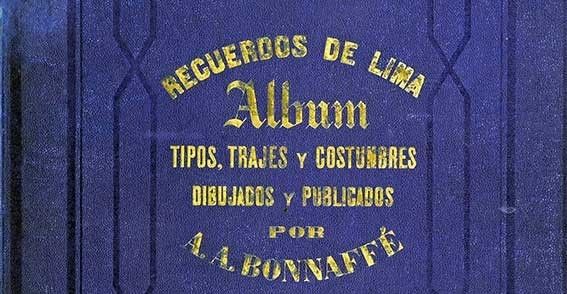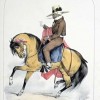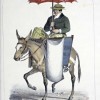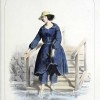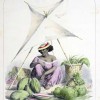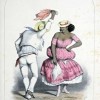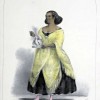Published in 1857 this beautiful album with 12 pictorial works by A.A. Bonnaffé about clothing, dresses, and typical personalities in the daily life of Lima in this century, it is a real jewel that you should look at.
Lithographed in Paris by Julien, E. Morin, V. Adam, J. Gaildreau, De Moraine, Didier, and printed by Lemercier the prints represent the memories of Lima by Bonnaffé during his 3-year visit.
A.A. Bonnaffé was a French artist living in Peru from 1855 to 1857. He left us with precious consumerist documents from Lima through magnificent watercolors, lithographs and drawings. There are no major references to his life, but his work of excellent narrative and artistic quality makes him a representative pioneer of past times for Peruvian art. His work is distinguished by an excellent drawing and firm line, configurations of correct proportion and natural movement; precise in capturing the themes and expressive in their interpretation.
Description of the Images in the Album
La Zamacueca
The Zamacueca is a Peruvian musical style and a loose couple dance, where the loving siege of a woman by a man is symbolized. We consider this musical style the mother of the cueca, the zamba, and the marinera. The terminology of “zamba” and “cueca” alludes to that siege similar to that carried out by roosters on hens and takes steps from the very popular cockfight in Lima and Trujillo festivals during the Viceroyalty of Peru during the Spanish Empire.
La Zamba
The denomination “zamba” referred in “old Peru” to the term that applies to the mestizo individuals descended from an American indigenous person and a black person.
El Capeador
The capeadores were true popular idols in Peru. Until the independence of Peru, they preserved bullfighting in the Spanish style in Acho (bullfight arena), but after 1824 and until the last third of the 19th century, chaos, military leaders, and internal struggles took hold of Peru. Acho, the nation's true social and cultural melting pot, followed the same trend. The capeadores on horseback, which were already popular since before 1821, became the protagonists and replaced the Spanish picadores that, after harassed, had left Peru. Blacks, a social group from which many of the Peruvian bullfighters came, took on greater relevance. The capeadores Esteban Arredondo and Manuel Monteblanco, excellent riders, engaged in an epic competition; there was no landowner in Lima who did not feel honored that either of them rode out on Acho riding his horse.
Chorrillos
The district of Chorrillos was officially established on the 2nd of January 1857. It is located directly on the Pacific Ocean south of Miraflores and Barranco. The lady we can see in the pictorial work is wearing a bathing suit typical for that period.
El Panadero
The baker. It seems that there has already been a convenient delivery service in those days.
La Placera
Translated literally from Spanish “La placera” means in English “the pleasure”. Most probably taking reference to the delicious products this woman is selling either in a market or on the street.
El Arriero
The muleteer. A muleteer, or more informally a muleskinner, is a person who transports goods using pack animals, especially mules. In Peru, muleteers used to transport a multitude of items and some can still be found in very remote areas where the infrastructure does not permit any modern means of transportation.
La Chichera
Chicha, as it is known in Spanish (“Akkha” in Quechua), is still one of the most important drinks for the Quechua people. Prepared at home, germinating maize kernels are ground and cooked to form a thick, beige-colored, fermented drink.
El Aguador
The water carrier. Before the establishment of running water in every home, Lima suffered under the despotic monopoly of the water carrier, because the one who needed it did not have water, if the water carrier did not want to give it. The water carrier, black or zambo, looked after his donkey more than his own children, and it was for the object of his most tender request.
La Lechera
The milkmaid. Engravings like this one from Bonnaffé recall the milkmaid mounted on horseback, with her pots tied to the sides and shouting her arrival–one of the most expected characters in the morning. A classic personality from the old Lima.
El Velero
The candlemaker. By municipal concession, on May 15, 1886, they inaugurated the electric public lighting in Lima that initially illuminated only the Plaza de Armas. Before that, lighting depended on wooden blocks smeared with grease, oil lamps, candles, kerosene lighters and, as of 1857 gas lighting. This explains the importance of the candlemaker, as this was an important daily commodity in every house in Lima.
La Caleza (Calesa)
Horse Carriage. Vehicle traffic in the Lima of the viceroys was so intense that it surprised the chroniclers of the 17th century and even European travelers up to the 18th century. Only with the Independence, and with the appearance of the massive means of transport such as the railroad, the steamship or the trolley car, the large number of horse carriages descended from a thousand to a few hundred.


